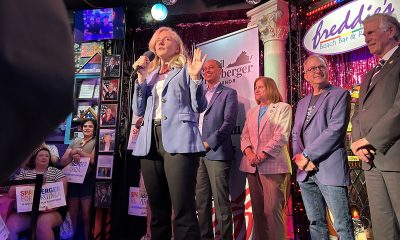Living
Back to School
How it got better at American University
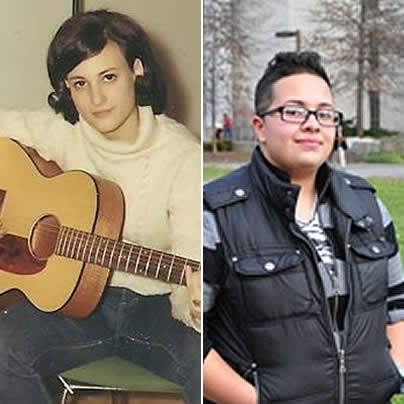
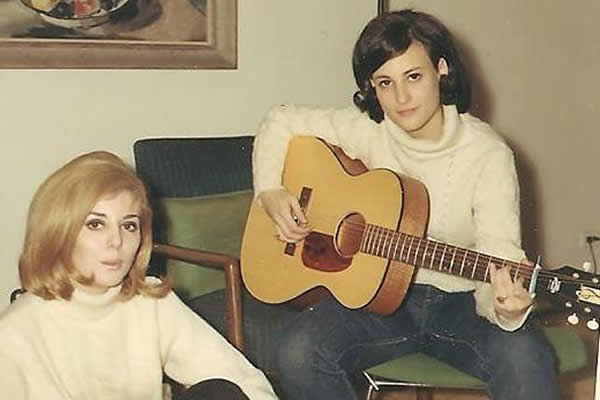
Fay Jacobs (AU, circa 1970) strumming in the dorm, at a very different time for gay students. (Photo courtesy of Jacobs)
Editor’s note: This is the third installment in our “Back To School” series assessing the LGBT climate on university campuses as told by alumni we’re pairing with current students to tell their stories. This week: Fay Jacobs and American University. Visit washingtonblade.com for previous installments.
On May 4, 1970, when the tragedy at Kent State burst onto the screen, Neil Young wrote the unforgettable anti-war lyrics “Tin soldiers and Nixon’s coming.” Fay Jacobs, a senior at American University was accustomed to participating in anti-war rallies on campus in front of the Mary Graydon Center. The news came only twice daily back then — broadcast on console TVs the size of today’s Mini Cooper. But the pot boiled over the next day on Cinco de Mayo with AU students protesting more vociferously than ever. Typically, the protests were handled by campus police, but this time, the D.C. police showed up with noxious tear gas.
Jacobs was in rehearsal for a French Operetta in the campus theater. When the tear gas missed the activists and landed on the steps of the theater, the actors, singers, musicians and men in tights all went running in different directions.
“I hid in the bushes with my pal Rob,” she recalls. “It was all very frightening. Except for the guys in tights running amok. Come on, that’s funny.”
You’d expect nothing less from a renowned comedy writer who’s published two books: “As I Lay Frying” and “Fried and True” — a woman whose favorite movie was “Funny Girl” and whose father taught her that no experience should be considered bad if you can tell a good story about it later. And so we sit to talk about her experiences at AU “back in the day” and the trek that brought her out of the closet and into the bright light of lesbianism.
It would be decades before Melissa Etheridge would walk across fire for another woman. So, like most of us in those days without visible gays, Jacobs focused on textbooks and the bard, lived isolated in the closet, conforming to hetero ideals and dated men.
Her focus was on politics and social justice. Long before RFK was a stadium named in memoriam, she campaigned for Robert F. Kennedy, the man. She vividly recalls the candlelight vigil the night Martin Luther King, Jr. was murdered. And the many war protests. She could wage a full-throated protest against the war but remain mute about the war within. It was just too risky. Her own struggle for authenticity would be deferred for a decade, until after she graduated and kicked down the closet door.
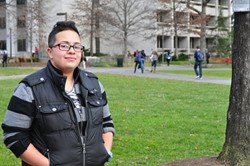
Salina Rivera (class of 2014) benefits from an LGBT student center on campus. (Photo by Josh Halprin)
AU senior Salina Rivera stands on the same steps of Mary Graydon Center 43 years later and points north.
“My girlfriend and I live about a five-minute walk that way,” she says. Ironically, it’s not far from where Jacobs’ closet was. Out since age 13, and so grateful for her loving parents, she’s only sorry that her father died before she could tell him.
“He was a corrections officer in that male-dominated environment, and yet he never made me feel odd for being the Tom Boy,” Rivera said. “We always played basketball together. I know he’d understand me.” After his untimely death, her mother carried the torch of accepting parent and is, today, Rivera’s straight hero. “I have never met a stronger, more loving person.”
With such solid loving support, the Bronx native blossomed. She was class president in high school and today she is proud to be one of seven founding sisters of AU’s chapter of the lesbian Gamma Rho Lambda sorority — one of five LGBTQ organizations on campus. Her queer peers can join other active organizations and have access to “Safe Space 2.0” and a course named “Trans 101.” She and her girlfriend attend campus events together — usually rallies for social justice. Holding hands. Ho hum. “It’s hard to believe students were ever in the closet here at AU,” Rivera said. “It’s so progressive and inclusive today, but I realize it’s a privilege not to be taken lightly.”
Erin Fuller, immediate past president of the AU Alumni Association, and a straight ally agreed.
“As a student in the 80’s, I watched in awe this year as the campus greeted the coming out of their immediate past president of student government as a transgender person with a collective, supportive shrug. I see the amazing work that the entire division of Student Life does to support everyone from first-generation college attendees to students celebrating their cultural, ethnic and sexual identities, and it makes me incredibly proud to be a part of something so wonderful and so important.”
In hindsight, Jacobs’ life blossomed quickly after she came out. She’s not at all bitter about the late start in life and that in her 31st year, it was time to write her own story. Today she’s driving back to her home in Rehoboth Beach from Dover, Del., where she’s celebrating the movement toward marriage equality with her straight hero, Delaware Gov. Jack Markell. She’s a local celebrity in Rehoboth. Her zany wife Bonnie is the love of her life and the subject of many of her regular columns in Letters from CAMP Rehoboth. From their madcap adventures in the RV, to their frequent visits to the ER, Jacobs chronicles their hysterical antics.
It wasn’t always a bed of roses for Jacobs. Shortly after graduation she married Bob, a classmate, who made a living playing the accordion. It wasn’t long before they both knew something was amiss. I ask if they got together after the break up to watch Lawrence Welk, where accordions ruled.
“No, I moved on, man-free and accordion-less.”
Barbara Gittings, the lesbian activist who picketed the White House in 1967 and founded Daughters of Bilitis is her gay hero.
“She was relentless, brave, determined and most importantly, a heck of a lot of fun,” Jacobs said. Pre-Stonewall, Barbara was one of several brave souls that demonstrated each year on the Fourth of July in Philadelphia. Asked about her gay hero, Rivera thinks for a moment and then points to the office of the coordinator of the LGBTQ Center where we are chatting: “It would be Matt Bruno. He’s unbelievable. Whether it’s help with a cover letter or a fight with my girlfriend, he’s always there for me.”
The Center of campus has an interesting story. Mary Graydon was a generous benefactor of AU until her death in 1926. She’s famous for focusing on the education of women, once saying, “I prefer to put money into brains rather than stone and mortar.” And so after many years of supporting women’s academics, the university honored her with stone and mortar. Her famous building is considered the center of campus and houses our LGBTQ Center.
Salina is reading Jacobs’ current column about how tiring the marriage fight is when you’re 60 something.
“I think Fay needs to come here and put her feet up and let us do some of the heavy lifting now,” Rivera said. She is planning to host Jacobs for a reading of her short stories in the LGBTQ Center this fall. Time has moved on. Jacobs graduated and came out. Nixon’s long gone. “Tin soldiers” include LGBT citizens. Nixon once lamented that “you can’t appreciate the view from the mountaintop until you’ve been in the darkest valley.” For entirely different reasons, Jacobs can relate.
So, hosted by Rivera and her queer peers, Jacobs can prop her feet up on Matt’s desk in a center that didn’t exist in her day. Holding her wife’s hand, she will read aloud her AU/GayU retrospective: “The tear gas was scary. I hid in the bushes for the riot and in the closet by necessity. But there were these men in tights running hither and yon and somehow I knew this story would be funny one day.”
Jacobs’ dad would be proud of her finding a good story in this. Mary Graydon’s investment in the brain trust of AU’s women has paid off in both gray matter and stone and mortar. We will tell our own stories from an LGBTQ Center.
Advice
How to cope when a partner gives you the silent treatment
Punishing behavior brings up memories of parent’s mistreatment
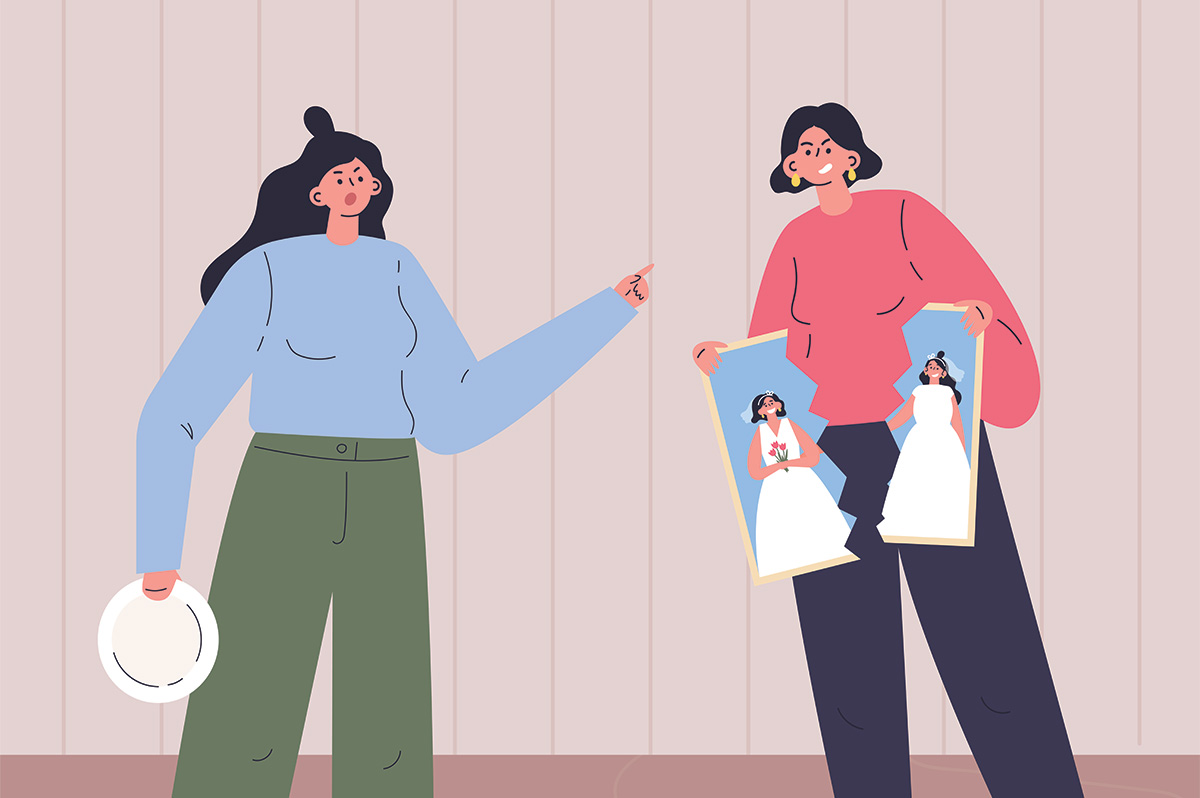
Michael,
My wife and I met less than two years ago and we were crazy about each other from the start. We wanted to spend life together so we just went for it. Maybe this wasn’t the most well-thought out decision on either of our parts but we thought that love conquers all.
But lately we’ve been arguing. The stuff we’re fighting about is never such a big deal: chores, or spending, or wanting to do different things on the weekend. But when I don’t want to go along with Michelle’s point of view, she gets angry and shuts down. Sometimes she stops talking to me for as long as a few days.
This is painful for me. My mom used to pull this stunt when I was a kid and she was mad at me. She also cut me off when I came out. We’re still estranged.
Michelle has a whole different take on this. She says I am being “mean” to her (when I don’t go along with what she wants) and this is painful, and she has to “take a break” to cool off.
I know she comes from a volatile family. She has told me there was a lot of screaming in her house, and she barely has a relationship with her parents as a result. So I get that she’s sensitive to conflict.
But I don’t think I’m being mean to her by standing up for what I want — certainly not enough to warrant her giving me the silent treatment.
We got married to have a great life together. We often do but I can’t live with someone who just shuts me out when she’s annoyed with me.
If I became a doormat and went along with everything she wants and never pushed back or complained, maybe she wouldn’t shut down. But I don’t want to do that.
I’d appreciate some ideas to improve the situation. I don’t want a divorce but I also don’t want to keep being mistreated.
Michael replies:
You can think of marriage — or any serious relationship — as a gym where you have ongoing opportunities to become an increasingly resilient person in the face of the ongoing challenges that an intimate relationship poses.
Your task here is to shift your focus toward figuring out how to handle yourself well, even in the awful circumstance of getting the silent treatment.
Michelle is not under an obligation to behave as you’d like her to. You can certainly ask her to stop withdrawing when she’s angry at you. But that doesn’t mean she is going to honor your request.
I well understand that Michelle’s punishing behavior is bringing up painful memories of your mother’s mistreatment. But if she doesn’t change her behavior, you have to find a way to live with Michelle as she is, with as much equanimity as you can muster, for as long as you choose to be married to her. If she does not change and you find her behavior to be unbearable, you can leave.
Every time she shuts down, Michelle is handing you an opportunity to figure out how you, yourself, can deal with feeling hurt and let down, rather than depending on someone else to behave as you’d like her to, or not upset you, or soothe you. Being in charge of your own mood rather than letting someone else press your buttons is a great skill to get better at.
I’m not going focus on what techniques you might use to soothe yourself — that’s a different column (or even better, a number of therapy sessions). That said, knowing that Michelle’s behavior comes from her history might help you to take it less personally. And, simply keeping in mind that living with a difficult spouse is unavoidable and worth getting better at may help you to quiet yourself down.
Another challenge that your marriage is pushing you to work on: Discerning when you can be generous, and when it is important to have a boundary. Of course, I understand that you don’t want to be a doormat by going along with whatever Michelle says and wants. But is it possible that she has a point, in that you could stand to lean more in her direction?
None of us get to have everything the way we want when we are in a relationship (much less in life). Figuring out the interplay between generosity and boundary is complicated. It often involves considering what is important to your partner; and deriving joy from her getting some of what is important to her, not only from your getting what you would like. And of course, it also involves figuring out what is most important to you.
If you set a boundary thoughtfully, because something is important to you, and Michelle doesn’t like it, you’re being handed an opportunity to get better at tolerating disappointment. Being a disappointment to your partner, and being disappointed in your partner, are both unavoidable parts of marriage: We’re all different, and at times will make choices that the other person really does not like.
If we make our decisions from a place of integrity rather than whim, entitlement, anger, or “whose turn it is”, and strive to honor the choices that our partners make from a place of integrity, this often makes the disappointment easier to bear.
Of course, it would be great if Michelle would join you in working to become a more solid and resilient spouse. As I mentioned earlier, you can’t persuade her to do so. But you can certainly tell Michelle what you are working on and ask her to consider how she, too, might use your relationship difficulties as a challenge to grow.
It isn’t easy to have such a conversation without sounding condescending. You are better positioned to do so when you are walking the walk, not just talking the talk. One good rule of thumb is to put you and your partner in the same boat, making it clear that you see the two of you as facing the same challenges, rather than positioning yourself in a superior position. Another is to initiate the conversation when you are both calm, rather than in the middle of a fight or when you’re getting the silent treatment.
One more point: If Michelle is willing, I’d suggest that you propose couples therapy as an opportunity for you two to collaborate on building a consistently loving relationship where neither of you lets your reactivity run the show.
Michael Radkowsky, Psy.D. is a licensed psychologist who works with couples and individuals in D.C. He can be found online at michaelradkowsky.com. All identifying information has been changed for reasons of confidentiality. Have a question? Send it to [email protected].

Electric-vehicle tax credits may have faded earlier this year, but EVs themselves are far from losing their spark. There are more charging stations than ever, battery ranges are longer and more realistic, and automakers have finally figured out that EVs don’t all need to look like geeky science projects or feel like failed beta tests.
Just look at these two compact electrics, which are futuristic, fun and flexible enough for work or play.
HYUNDAI IONIQ 5
$37,000 to $48,000
Range: 245 to 318 miles
0 to 60 mph: 4.5 to 7.4 seconds
Cargo space: 26.3 cu. ft.
PROS: Fast charging. Roomy cabin. Silky-smooth suspension.
CONS: Wide turning radius. Rear wiper not on all trims. Price creep.
After being introduced three years ago, what’s new for the latest Hyundai Ioniq 5? Mostly refinement. Charging is quicker, software is smarter and Hyundai continues to quietly listen to feedback, tweaking ride comfort and usability. Think of it as switching from messy eyeliner to a perfectly sharp wing.
Exterior styling remains one of this EV’s biggest conversation starters. Those pixel-inspired lights, crisp lines and slick hatchback-meets-crossover proportions exude refreshing confidence. There’s no trying to blend in, and that’s the point. Park this Hyundai anywhere and heads will turn.
On the road, the Ioniq 5 prioritizes calm over chaos. Steering is light, the suspension smooths out rough pavement and acceleration feels brisk without being aggressive. Safety tech is plentiful and well-calibrated—adaptive cruise control, lane-centering, blind-spot monitoring—all working together without seeming like a nervous backseat driver. IOW, this ride is supportive, not clingy.
Inside, the user-friendly cabin shines. The flat floor and long wheelbase create a lounge-like atmosphere, with excellent legroom and airy visibility. Seats are well-bolstered and available with eco-friendly materials, and the sliding center console adds flexibility. Cargo space is generous, and the wide windshield makes city driving stress-free. Alas, the rear wiper is only available on select models. Overall, though, I appreciated how everything looks modern without feeling cold.
What makes this Hyundai special is its vibe. An EV that embraces individuality without shouting about it.
Fun fact: The Ioniq’s ultra-fast charging can add hundreds of miles in under 20 minutes—perfect for those who hate waiting almost as much as they hate small talk on awkward first dates.
VOLKSWAGEN ID.4
$46,000 to $59,130
Range: 206 to 291 miles
0 to 60 mph: 4.4 to 7.7 seconds
Cargo space: 30.3 cu. ft.
PROS: Sure handling. Decent range. Good storage.
CONS: Body roll in curves. Fussy infotainment. No frunk.
The latest VW ID.4 focuses on polish. Software updates have fixed earlier frustrations, and overall drivability feels more cohesive. Less “learning curve” and more “hop in and go,” like a dependable bestie who doesn’t overthink things.
Styling-wise, this EV is intentionally inoffensive. Soft curves, friendly lighting and a familiar crossover shape make it approachable. While the ID.4 won’t turn heads like the Ioniq 5, that’s OK. It’s more akin to a classic outfit that always works—timeless, not trendy.
Driving the ID.4 is relaxed and predictable. This SUV prioritizes comfort over thrills, with a suspension tuned for daily commuting and long highway drives. Safety features are comprehensive and reassuring, including excellent lane assistance and collision-prevention systems. It’s the kind of car that quietly has your back, no drama required.
Inside, the ID.4 offers a calm, uncluttered cabin with good space for passengers and cargo alike. Rear-seat legroom is especially strong, making it a solid road-trip companion. The seats are plush, visibility is good and while the infotainment system isn’t the most intuitive, it’s improved enough to be more than tolerable.
The ID.4’s special sauce is balance. It doesn’t try to reinvent the wheel—it just electrifies it.
Fun fact: This is one of the most globally popular EVs, proving that sometimes being universally liked is a strength, not a personality flaw. Think, gold star gay who still surprises you.

Real Estate
Child- and pet-proofing your home for the holidays
It isn’t about being perfect but about being prepared

The holidays are meant to be joyful, cozy, and full of laughter — but if you have young children or pets, they can also feel a little chaotic. Twinkling lights, shiny decorations, guests coming and going, and tables full of tempting food can turn your home into a wonderland of curiosity and mischief. The good news? With a little thoughtful planning, you can keep the holiday magic alive while making your home safer for everyone who lives there.
There’s something oddly comforting about movies where animals go to war with holiday decorations, turning carefully strung lights and perfectly placed ornaments into chaos. Whether it’s a mischievous dog tangled in tinsel or a curious cat launching a full-scale assault on a Christmas tree, these scenes tap into a universal experience for pet owners.
The humor comes from the contrast: the human characters are trying to create warmth, tradition, and picture-perfect cheer, while the animals see the decorations as toys, obstacles, or personal enemies. The resulting destruction — trees tipping over, ornaments shattering, lights blinking out—feels exaggerated but relatable, especially during the already hectic holiday season.
Let’s start with decorations because they tend to be the biggest attraction. Ornaments sparkle, garlands dangle, and everything seems designed to be touched, pulled, or tasted. If you have little ones or pets, consider placing your most fragile ornaments higher on the tree and using shatterproof options on the lower branches. Tinsel and ribbon may look festive, but they can be dangerous if swallowed, so skipping them or keeping them well out of reach is a simple way to reduce risk without sacrificing style.
Holiday lights are another favorite fascination. Before hanging them, take a few minutes to inspect each strand for frayed wires or broken bulbs. Secure cords along walls or behind furniture so they’re harder to grab or chew and unplug them when you leave the house or head to bed. Not only does this help prevent accidents, but it also gives you one less thing to worry about during a busy season.
The Christmas tree itself can become a focal point for exploration. Make sure it’s sturdy and well-anchored so it doesn’t tip if a toddler tugs on a branch or a pet decides to investigate. If you use a real tree, cover the water base since tree water can contain additives that aren’t safe if consumed. For artificial trees, keep an eye out for loose pieces or needles that could become choking hazards.
Food is a big part of holiday celebrations, and it’s also one of the most common sources of trouble. Many traditional treats—like chocolate, grapes, raisins, alcohol, and foods containing xylitol—are dangerous for pets. Keep plates and serving dishes up high, secure the trash can, and gently remind guests not to slip pets or kids “just a little bite” without checking first. For children, be mindful of hard candies, nuts, and small treats that could pose choking risks.
Candles and fireplaces add warmth and charm, but they deserve extra caution. Flameless candles are a wonderful alternative if you want ambiance without worry. If you do use real candles, place them well out of reach and never leave them unattended. Fireplaces should always have a sturdy screen or gate, especially with crawling babies or curious pets nearby.
Holiday gatherings bring wonderful energy into your home, but they can also create new challenges. Doors opening frequently make it easier for pets to slip outside, so consider setting up a quiet, comfortable space where they can relax during busy get-togethers. This can help reduce stress for them and give you peace of mind. For children, stair gates, locked cabinets, and clear boundaries can help prevent accidents when there’s extra excitement in the air.
New toys and gifts are another thing to watch closely. Packaging, twist ties, plastic wrap, and especially button batteries should be cleaned up promptly. These items are easy to overlook in the excitement of gift-opening but can be dangerous if swallowed. Taking a few minutes to tidy up as you go can make a big difference.
Lastly, try to keep routines as steady as possible. The holidays naturally disrupt schedules, but familiar mealtimes, naps, walks, and bedtime rituals help children and pets feel secure. A calmer household often means fewer accidents and a happier experience for everyone.
At the end of the day, child- and pet-proofing your home for the holidays isn’t about being perfect but about being prepared. A few small adjustments can help you relax, enjoy your guests, and focus on what truly matters: creating warm, happy memories with the ones you love. When your home feels safe, the holidays feel even sweeter.
Valerie M. Blake is a licensed Associate Broker in D.C., Maryland, and Virginia with RLAH @properties. Call or text her at 202-246-8602, email her at [email protected] or follow her on Facebook at TheRealst8ofAffairs.
-

 National4 days ago
National4 days agoWhat to watch for in 2026: midterms, Supreme Court, and more
-

 Colombia5 days ago
Colombia5 days agoBlade travels to Colombia after U.S. forces seize Maduro in Venezuela
-

 Virginia5 days ago
Virginia5 days agoLGBTQ groups to join Spanberger inaugural parade
-

 Minnesota5 days ago
Minnesota5 days agoTim Walz drops out of Minn. governor’s race

















